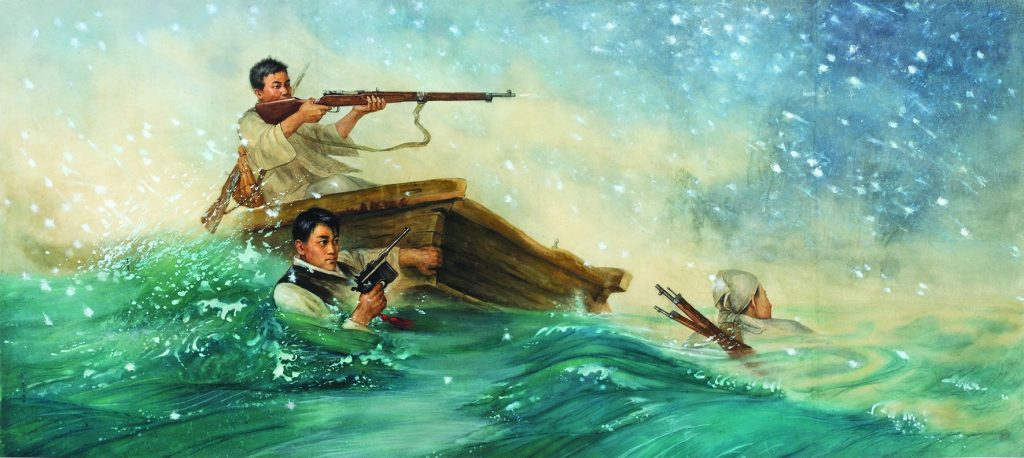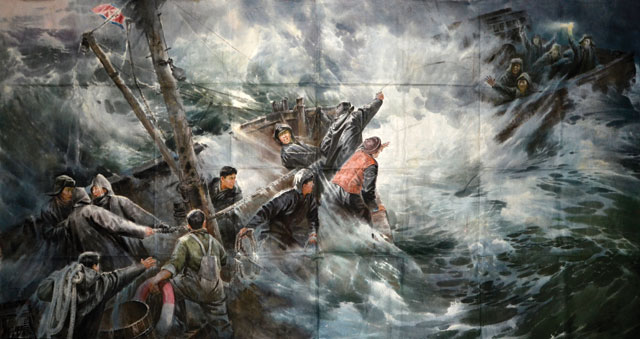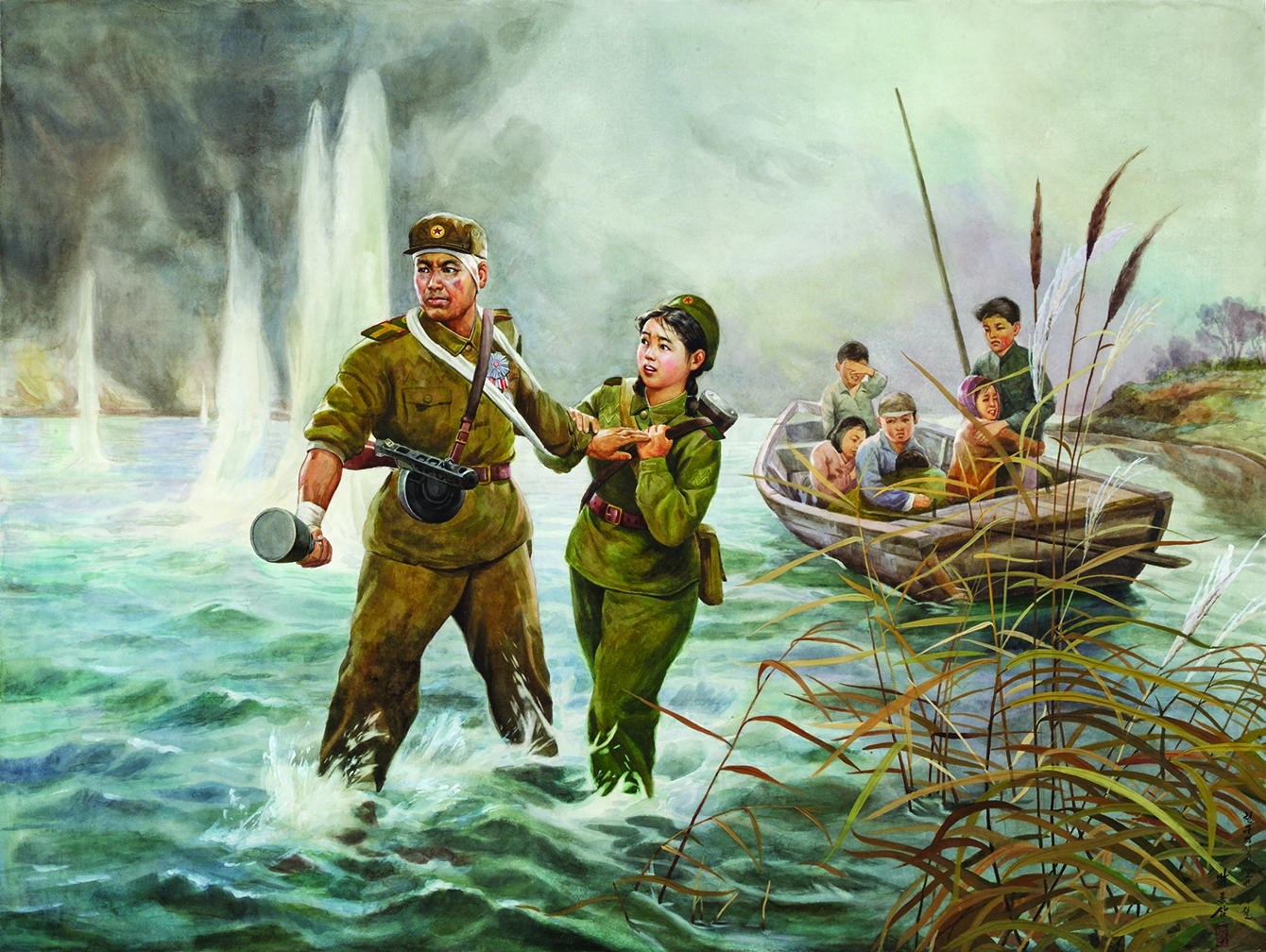A Trip into the Dark Heart of North Korea in Contemporary North Korean Art: The Evolution of Socialist Realism at the American University Museum
By Brendan L. Smith
Through the distant lens of the outside world, North Korea exists somewhere between a farce and a tragedy.
The bizarre jingoistic announcements from young, chubby-cheeked dictator Kim Jong-un raise eyebrows and deliver punch lines in the West. But the escalating nuclear tests of an unhinged totalitarian regime have triggered crippling international sanctions that have impoverished innocent citizens trapped in that oppressive country.
Art rarely enters the conversation when we talk about the ironically named Democratic People’s Republic of Korea, but the first-ever U.S. exhibition of North Korean propaganda artwork at the American University Museum offered a rare glimpse into a secretive world where art’s main function is to serve the government. Despite their mandatory role as puppets in a master scheme, these unheralded artists also display an unrivaled mastery of Chosonhwa, an exacting centuries-old technique of ink wash painting on rice paper. Can propaganda truly be art? It’s a question still seeking an answer in North Korea.

The exhibition, titled Contemporary North Korean Art: The Evolution of Socialist Realism, featured 23 original or replica paintings from the Mansudae Art Studio dating from the 1960s to a work still in progress. The studio in Pyongyang is the largest state-run art production facility in the world, sprawling across 30 acres with 1,000 of the country’s most talented artists working with 3,000 support staff.
Minimally funded by the government, the studio cranks out countless murals, posters, paintings, ceramics, and monumental sculptures to glorify the desired themes and inflated egos of the regime’s leaders. Since the collapse of the Soviet Union and thawing of the Cold War, North Korea is the only place in the world where Socialist Realism is still the dominant style. No one is painting majestic portraits of Stalin or chiseling statues of Lenin anymore, so Kim Yong-un is the first in line.

I had a private tour of the exhibition with curator B.G. Muhn, a Georgetown University art professor and artist who grew up in South Korea. He wrangled his way into North Korea several times over the past five years and befriended many artists at the Mansudae facility. He sometimes flew to China without knowing whether his visa would be approved by the capricious North Korean regime.
Due to political issues, Muhn had to borrow or buy the artwork in the exhibition through his own fundraising, with pieces ranging in price from $8,600 to a staggering $350,000. As the sole remaining contemporary examples of Socialist Realism, North Korean artwork is sought by collectors in Asia and Europe, but much less so in the United States.
“Our general notion of North Korean art is propaganda,” Muhn said while we walked through the gallery. “In a big sense, that is true, but there are a variety of expressions that have nothing to do with propaganda.”
As a mixed-media artist, I wanted to see the exhibition because of its unusual subject matter, but I assumed I would find amateurish renderings of proud soldiers and happy workers, indoctrinating schoolbook illustrations writ large for the masses. Much of the earlier work, with its flat planes and lifeless characters, lived up to my low expectations, but the evolution of the artwork over half a century is amazing both for what changes and what doesn’t.
The technical and emotional mastery of Chosonhwa leaps forward in beauty and detail, while the ideological subject matter remains mired in the same deep ruts of propaganda, except for a few paintings that escape those narrow confines through the skills of the artists.
While most of the paintings in the exhibition are original, nine pieces are replicas of paintings dating from the 1960s to 1980s, but that distinction isn’t noted in the wall text, which Muhn admits was a mistake. The replicas were sanctioned by the Choson National Museum of Art in Pyongyang because the originals are considered “national treasures” that can’t leave the country.
Signing the name of the original artist to a replica created by another artist would be considered forgery almost anywhere in the world, but it’s common in North Korea where an artist’s personal expression is subsumed by the will of the state.

Several of the replicas of artwork from the 1970s are interchangeable in their subject matter and soulless execution, like playing cards pulled from the same deck. In Farewell, a stone-faced soldier holding a long-handled stick grenade stands in ankle-deep water while his fearful female compatriot pulls on his sleeve. A boat filled with children bobs in the water behind them while geysers of water from mortar fire launch into the air. The soldier presumably is headed off on a one-man suicide mission to vanquish an unseen foe in a valiant effort to protect defenseless women and children.

Charging Forward to the Battlefield is another tired snapshot of another waterborne battle where a male and female soldier possessed with superhuman strength use a single oar to push a raft carrying a military truck and artillery cannon through crashing waves. But these blank figures don’t break a sweat or show any signs of life as they stare blankly toward the horizon like frozen statues.
However, another seaside assault called After Securing Arms originally painted in 1968 somehow avoids the same fate. Three men in civilian clothes armed with rifles and a handgun, one in a small wave-swept wooden raft and the others swimming under falling snow, again stare into the distance and fire at an unseen foe, but I could picture myself riding in a raft next to them.
The sea subtly shifts from cascading waves threatening to capsize the raft to a tranquil pool rippling around the first figure. The flecks of sea foam overlap with the flakes of snow, creating a sense of atmosphere and mystery. Where are these men going and just where did they secure their arms? The painting is permeated with the same taint of propaganda, but the downturned lips of one man and the heavy-lidded eyes of another register fear rather than heroics, belying the myths we tell each other about the glories of war.
The propaganda gradually shifts gears to glorify the industrial machinery of the state. In 2015, a team of six artists painted Joyfully Anticipating the Completion of the Dam, a truly massive work stretching more than 14 feet long that displays incredible technical skill, but it features the most cheerful laborers the world has ever seen. With unsettling ear-to-ear grins, they effortlessly heave ropes tied to a giant pipe section, revealing one of the many contradictions of daily life in North Korea.

Modern infrastructure still gets built with brute force and backbreaking labor, except the real workers aren’t smiling. By contrast, another painting called A Worker by Choe Chang Ho offers a more realistic and compassionate portrayal of one of those anonymous workers, a seated man with soiled clothes and clasped hands who looks weary and resigned to his fate, just another forgotten cog in a state-run machine.
One of the most fascinating pieces in the exhibition also is the most recent, a work in progress called Rain Shower at the Bus Stop by Kim In Sok. The street scene, which fades to sketches around the edges, depicts ordinary citizens in Pyongyang sheltering themselves from a passing rain storm, except for a central female figure who has lowered her umbrella and raised her gaze. She is based on a shy woman whom the artist met on the street, and her slight smile offers an appreciation of the gentle touch of falling rain against her skin and that fleeting moment of solitude that can still be found amidst a throng of people. There are no stoic soldiers, no grinning workers.
In addition to buying artwork for the exhibition, Muhn borrowed several pieces from the Mansudae Art Studio Gallery in Beijing, which is run by the North Korean government. Muhn said profits from art sales go to the artists rather than the North Korean dictatorship, but it seems impossible to determine that with any certainty, which raises some ethical issues for buyers. The gallery directs sales through an Italian company to avoid political entanglements or buyers’ fears of dealing directly with the North Korean regime.

The Mansudae gallery’s website claims the art facility in Pyongyang is not a chain factory but then describes its 13 creative groups, seven manufacturing plants, and more than 50 supply departments. Artists often work in teams on large pieces. Muhn said many of the artists he met had a deep well of talent with most of them graduating from Pyongyang Art College, the most prestigious art school in the country.
Artists are revered but struggle to survive like everyone outside the military and political elite in North Korea. Due to their isolation, the artists who Muhn met had very little knowledge or respect for contemporary art outside their country. “Even when they are given some artistic freedom, they don’t know what to express except the routine subject matter,” Muhn said. “Most people consider their work to be kitsch.”
But the same could be said for much contemporary art around the world, Muhn said. While North Korean art satisfies the demands of the government elite, most high-priced contemporary art is geared toward an elite circle of wealthy collectors, galleries, and auction houses. “The rest of it is all kitsch, but we don’t realize that,” he said.
Can propaganda truly be art? It’s the central question of this unique exhibition, and the answer is influenced by the talent of the artist and the preconceived notions of the viewer.
As a fellow artist, I feel deeply sympathetic toward these artists who are trapped both physically and creatively by their brutal government, cocooned inside an unyielding system that cuts them off from the ideas and inspiration of a community of artists around the world. They must struggle to feed their families while continuing a centuries-old artistic tradition, creating realistic and at times deeply personal scenes using just ink and rice paper.
But the worlds they create are populated with dark fantasies of a lurking enemy. For more than half a century, the North Korean dictatorship has tried to convince its people, through art disguised as propaganda or propaganda disguised as art, that the enemy is the United States or some vague hostile force, but the truth resides much closer to home with the regime itself.
*****
Brendan L. Smith is a freelance journalist and mixed-media artist in Washington, D.C.
Contemporary North Korean Art: The Evolution of Socialist Realism at the American University Museum was up from June 18 through August 14, 2016.






